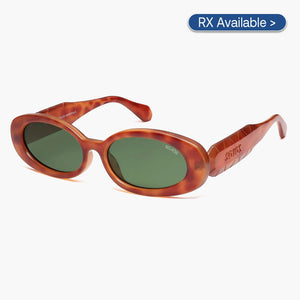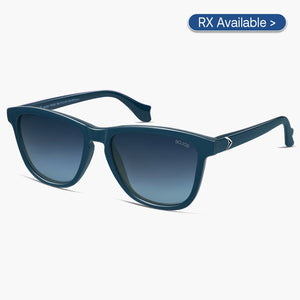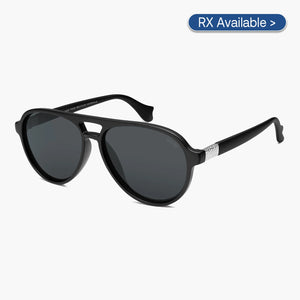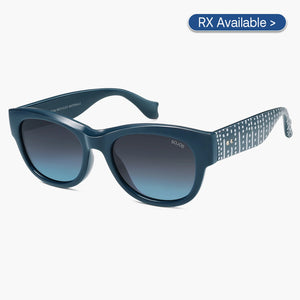Sunglasses are not only a stylish accessory but also a crucial tool for protecting our eyes from harmful ultraviolet (UV) rays and glare. To understand sunglasses better, it's important to delve into the materials that make up these essential eyewear pieces.
Sunglasses Lens Materials
The lenses of sunglasses are a crucial component that directly affects the clarity of vision, level of protection, and overall performance of the eyewear. Sunglass lenses are available in various materials, each offering distinct advantages and characteristics.

Glass Lenses
Glass lenses have a long history in sunglasses manufacturing. They provide exceptional optical clarity, offering the most accurate and distortion-free vision. Glass lenses are scratch-resistant, providing long-lasting durability. However, they are heavier compared to other lens materials, which can make them less comfortable to wear for extended periods. Moreover, glass lenses are more susceptible to breakage, making them less ideal for high-impact activities.
Plastic Lenses
Plastic lenses, particularly CR-39 and polycarbonate, have gained popularity due to their lightweight nature and impact resistance. CR-39 lenses are made from a lightweight plastic material known as allyl diglycol carbonate. They offer good optical quality, although not as high as glass lenses, and are more affordable. Polycarbonate lenses, on the other hand, are highly impact-resistant, making them ideal for sports and active lifestyles. They are also thinner and lighter than CR-39 lenses, providing enhanced comfort. Polycarbonate lenses are often recommended for children's sunglasses due to their durability.
Other Lens Materials
In addition to glass and plastic, there are other lens materials that offer unique properties and purposes. Nylon lenses, also known as polyamide lenses, are lightweight and highly impact-resistant, making them suitable for sports eyewear. They are also more flexible than other materials, reducing the risk of breakage. Acrylic lenses are lightweight and offer good optical clarity. They are often used in lower-cost sunglasses or as an alternative to glass lenses. However, acrylic lenses are more prone to scratching and may require more frequent replacement.
When selecting lens materials for sunglasses, it is important to consider factors such as desired optical clarity, impact resistance, weight, and budget. Glass lenses provide the highest level of clarity but are heavier and more fragile. Plastic lenses, such as CR-39 and polycarbonate, offer a lighter and more durable option. Nylon and acrylic lenses provide their own advantages, particularly in terms of impact resistance and cost-effectiveness.
It is also worth noting that lens materials can be combined with various coatings and treatments to enhance their performance. These coatings can include UV protection, polarization to reduce glare, anti-reflective coatings to minimize reflections, and scratch-resistant coatings to improve durability.
Ultimately, the choice of lens material depends on individual needs, preferences, and activities. Whether you prioritize optical clarity, impact resistance, or lightweight comfort, selecting the appropriate lens material will ensure optimal vision and protection while enjoying your sunglasses.
Sunglasses Frame Materials
The frames of sunglasses are not only crucial for holding the lenses securely but also contribute to the overall aesthetics, durability, and comfort of the eyewear. There are several materials commonly used in sunglasses frames, each offering its own unique set of characteristics.
Metal Frames
Metal frames have long been a popular choice for sunglasses due to their strength, sleek appearance, and durability. Stainless steel frames are corrosion-resistant, lightweight, and hypoallergenic, making them suitable for individuals with sensitive skin. Titanium frames are known for their exceptional strength-to-weight ratio, making them incredibly lightweight yet highly durable. They are also resistant to corrosion and ideal for those seeking maximum comfort. Aluminum frames are lightweight and provide excellent resistance to corrosion, making them a practical option for outdoor activities.

Plastic Frames
Plastic frames are versatile, and lightweight, and offer a wide range of design possibilities. Cellulose acetate, a plant-based material, is widely used in eyewear manufacturing. It is known for its flexibility, durability, and ability to hold vibrant colors, patterns, and textures. Nylon frames, made from polyamide, are exceptionally lightweight and offer excellent impact resistance, making them suitable for active individuals. They are also resistant to heat and chemicals, adding to their durability. Additionally, injection-molded plastics, such as propionate and polyurethane, provide affordability and design flexibility.
Other Frame Materials
In addition to metal and plastic, sunglasses frames can be made from alternative materials with unique characteristics. Wood frames have gained popularity for their natural, eco-friendly appeal. They are lightweight, comfortable, and can be crafted from sustainably sourced materials. Bamboo frames, in particular, are lightweight and have a distinctive grain pattern. These materials provide a stylish, earthy look and are ideal for individuals seeking a more sustainable option. Additionally, some sunglasses feature frames made from innovative materials like carbon fiber or TR-90, a thermoplastic material known for its flexibility and impact resistance.
Choosing the right frame material depends on individual preferences, lifestyle, and desired style. Metal frames are often favored for their sleek appearance, durability, and lightweight feel. Plastic frames, on the other hand, offer a wide range of design options, colors, and patterns, appealing to those seeking bold or unique styles. Alternative frame materials like wood or bamboo provide a natural, environmentally conscious choice.
It's important to note that sunglasses should fit comfortably and securely on the face regardless of the frame material. Proper fit ensures optimal eye protection and reduces the risk of discomfort or slippage during activities. When selecting sunglasses, consider not only the frame material but also factors such as frame style, lens technology, and UV protection to ensure a well-rounded choice that suits both your functional and fashion needs.
METAL FRAMES RECOMMENDED
Coatings and Treatments
Sunglasses often feature coatings and treatments that enhance their functionality and performance. UV protection is a vital feature, as it shields our eyes from harmful UV radiation, which can lead to various eye problems. Polarized lenses reduce glare and enhance visual clarity, particularly in high-glare environments. Anti-reflective coatings minimize reflections and improve visual comfort, while mirrored coatings add a stylish touch while reducing brightness. Scratch-resistant coatings help preserve the lens integrity and longevity.
Other Components
Beyond lenses and frames, sunglasses consist of various components that contribute to their overall functionality and comfort. Hinges and temple arms ensure flexibility and proper fit. Nose pads and bridges, available in different materials, play a significant role in comfort and adjustability. Furthermore, decorative elements like embellishments and logos provide aesthetic appeal and branding.
Conclusion
Understanding the materials used in sunglasses sheds light on the importance of selecting appropriate eyewear based on their properties and functions. By recognizing the significance of these materials and components, we can make informed decisions when selecting sunglasses that not only protect our eyes but also match our personal style. Remember, proper care and maintenance are essential for prolonging the lifespan of your sunglasses and enjoying optimal eye protection.





